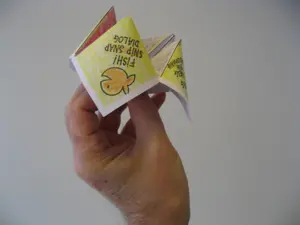Download DIY Workshop about reciprocity: Choose your boomerang
Choose your boomerang
Order the exercise and have it delivered in your mailbox. Download the exercise and print the conversation cards and be ready in less than10 minutes.
Reciprocity Urge is a basic, human drive that we all have within us. It forces us to return favours for favours, kindness for kindness, gifts for gifts, anger for anger.
When you are offered a free sample in a supermarket, you feel an urge to buy to reciprocate. Maybe you end up buying nothing, but you continue on with the urge. In a very short time, the 'salesperson’ gives you both a smile, friendly attention, an interest and a taste sample. You will automatically reciprocate most of it before you decide whether you also want to buy.
The oldest human drive
Examples of this urge to reciprocate have been found in all civilizations throughout history. It has been seen in all peoples and also in monkeys. This urge has been identified as a crucial component of major religions.
Smile to the world (the boomerang)
One thing that always comes back to the 'sender' is a boomerang. Originally, a boomerang was a hunting weapon. It is a good example of reciprocity urge. Sometimes we say: 'Smile at the world and the world smiles at you.' or 'Treat your neighbour as you would like to be treated.'
Good and bad boomerangs
Both good things and bad things come back to the sender. When you say 'Good morning', a 'Good morning' comes back. When you say 'Hi’ it also comes back. It is rare that the answer is, for example, 'Good afternoon'. You respond with the same answer. Then there is balance in the relationship.
Take a good look at yourself
Often we are not even aware of the negative boomerangs we throw out. Therefore, it is crucial that we have a high degree of awareness of what we ourselves are doing. The first thing you need to do is figure out which boomerangs you throw.
Choose your boomerangs consciously
The strength behind reciprocity urge is that you can influence other people's behaviour. You can consciously choose your boomerangs. If, for example, you want other people to be open to new things, then this is the boomerang you have to throw. For example, you can choose to throw your patient boomerang, your creative boomerang, your curious boomerang. Next time your phone rings, try choosing the curious boomerang. Regardless of who is on the phone, be curious. In this way, you arouse curiosity in the other person. Then it ends up that you are curious about each other.
Choose your boomerang
When you discover that you can choose your boomerang from situation to situation and from relationship to relationship, you also discover that you control the behaviour of your relationships. It's not just because you're a nice person. It's because you've chosen to be a nice person and send out nice boomerangs that comes back to you in the form of nice behavior and nice actions.
There is no reviews yet. Be the first to write us your opinion










